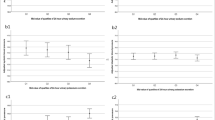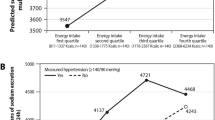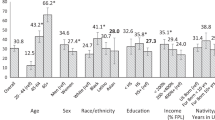Abstract
Hypertension has become a major public health challenge, and previous studies have observed associations between hypertension and sodium, potassium, and sodium to potassium ratio. However, little is known about how the whole continuum of blood pressure (BP) is related to dietary intake of sodium and potassium. This study aims to examine quantile-specific associations of blood pressure with dietary intake of sodium and potassium. It is based on national-level, cross sectional data for US adults aged ≥18 years from the National Health and Nutrition Examination Survey (NHANES) 2007–2014. A total of 11,095 eligible subjects were included in this study. Quantile regression (QR) models were used to investigate distributional effects in the dietary intake of sodium and potassium on blood pressure by adjusting the confounding factors. We observed some evidence indicating distributional effects of dietary intake of sodium and potassium on systolic blood pressure (SBP) and diastolic blood pressure (DBP). QR showed that the consumption of sodium was positively associated with SBP (P10) and DBP (P10) in males, and positively associated with DBP (P80–P90) alone in females. Intake of potassium was, however, negatively associated with SBP (P20–P30, P70–P80) in males, and also negatively associated with SBP (P10–P80) and DBP(P20–P50) in females. Sodium to potassium ratio was positively associated with SBP (P10–P50, P80) and DBP (P70–P90) in males, and was positively associated with SBP(P10–P70, P90) in females. QR models provided a more detailed view on associations of SBP and DBP with the dietary intake of sodium and potassium and uncovered the quantile-related patterns.
This is a preview of subscription content, access via your institution
Access options
Subscribe to this journal
Receive 12 digital issues and online access to articles
$119.00 per year
only $9.92 per issue
Buy this article
- Purchase on Springer Link
- Instant access to full article PDF
Prices may be subject to local taxes which are calculated during checkout



Similar content being viewed by others
References
Yoon SS, Ostchega Y, Louis T. Recent trends in the prevalence of high blood pressure and its treatment and control, 1999-2008. NCHS Data Brief. 2010;48:1–8.
Heidenreich PA, Trogdon JG, Khavjou OA, Butler J, Dracup K, Ezekowitz MD, et al. Forecasting the future of cardiovascular disease in the United States: a policy statement from the American Heart Association. Circulation. 2011;123:933–44.
Yoon SS, Gu Q, Nwankwo T, Wright JD, Hong Y, Burt V. Trends in blood pressure among adults with hypertension: United States, 2003 to 2012. Hypertension. 2015;65:54–61.
Mozaffarian D, Benjamin EJ, Go AS, Arnett DK, Blaha MJ, Cushman M, et al. Heart disease and stroke statistics-2016 update: a report from the American Heart Association. Circulation. 2016;133:e38–360.
Forouzanfar MH, Liu P, Roth GA, Ng M, Biryukov S, Marczak L, et al. Global burden of hypertension and systolic blood pressure of at least 110 to 115 mmHg, 1990–2015. J Am Med Assoc. 2017;317:165–82.
Murray CJ, Lopez AD. Global mortality, disability, and the contribution of risk factors: global burden of disease study. Lancet. 1997;349:1436–42.
Kearney PM, Whelton M, Reynolds K, Muntner P, Whelton PK, He J. Global burden of hypertension: analysis of worldwide data. Lancet. 2005;365:217–23.
Lawes CM, Vander Hoorn S, Rodgers A. Global burden of blood-pressure-related disease, 2001. Lancet. 2008;371:1513–8.
Lim SS, Vos T, Flaxman AD, Danaei G, Shibuya K, Adair-Rohani H. et al. A comparative risk assessment of burden of disease and injury attributable to 67 risk factors and risk factor clusters in 21 regions, 1990–2010: a systematic analysis for the global burden of disease study 2010. Lancet. 2012;380:2224–60.
Elliott P, Walker LL, Little MP, Blair-West JR, Shade RE, Lee DR, et al. Change in salt intake affects blood pressure of chimpanzees: implications for human populations. Circulation. 2007;116:1563–8.
Ducher M, Fauvel JP, Maurin M, Laville M, Maire P, Paultre CZ, et al. Sodium intake and blood pressure in healthy individuals. J Hypertens. 2003;21:289–94.
Aburto NJ, Ziolkovska A, Hooper L, Elliott P, Cappuccio FP, Meerpohl JJ. Effect of lower sodium intake on health: systematic review and meta-analyses. BMJ. 2013;346:f1326.
He FJ, Li J, Macgregor GA. Effect of longer term modest salt reduction on blood pressure: cochrane systematic review and meta-analysis of randomised trials. BMJ. 2013;346:f1325.
Binia A, Jaeger J, Hu Y, Singh A, Zimmermann D. Daily potassium intake and sodium-to-potassium ratio in the reduction of blood pressure: a meta-analysis of randomized controlled trials. J Hypertens. 2015;33:1509–20.
Sun X, Peng L, Manatunga A, Marcus M. Quantile regression analysis of censored longitudinal data with irregular outcome-dependent follow-up. Biometrics. 2016;72:64–73.
Centers for Disease Control and Prevention. The national health and nutrition examination survey. Centers for Disease Control and Prevention. https://www.cdc.gov/nchs/nhanes/index.htm
Agricultural Research Service, Food Surveys Research Group. Food and nutrient database for dietary studies. Beltsville, MD: Agricultural Research Service, Food Surveys Research Group. https://www.ars.usda.gov/northeast-area/beltsville-md-bhnrc/beltsville-human-nutrition-researchcenter/food-surveys-research-group/docs/fndds-download-databases/
National Center for Health Statistics. National Health and Nutrition Examination Survey: Estimation procedures, 2011–2014. https://www.cdc.gov/nchs/data/series/sr_02/sr02_177.pdf
National Center for Health Statistics. National Health and Nutrition Examination Survey: Estimation procedures, 2007–2010. https://www.cdc.gov/nchs/data/series/sr_02/sr02_159.pdf
Koenker R, Bassett G. Regression quantiles. Econometrica. 1978;46:33–50.
Do YK, Foo K, Ng YY, Ong ME. A quantile regression analysis of ambulance response time. Prehosp Emerg care. 2013;17:170–6.
Zhang Z, Cogswell ME, Gillespie C, Fang J, Loustalot F, Dai S, et al. Association between usual sodium and potassium intake and blood pressure and hypertension among US adults: NHANES 2005–2010. PLoS ONE. 2013;8:e75289.
Stolarz-Skrzypek K, Liu Y, Thijs L, Kuznetsova T, Czarnecka D, Kawecka-Jaszcz K, et al. Blood pressure, cardiovascular outcomes and sodium intake, a critical review of the evidence. Acta Clin Belg. 2012;67:403–10.
He FJ, Li J, Macgregor GA. Effect of longer term modest salt reduction on blood pressure: Cochrane systematic review and meta-analysis of randomised trials. BMJ. 2013;346:f1325.
Cogswell ME, Zhang Z, Carriquiry AL, Gunn JP, Kuklina EV, Saydah SH, et al. Sodium and potassium intakes among US adults: NHANES 2003-2008. Am J Clin Nutr. 2012;96:647–57.
US Department of Health and Human Services; US Department of Agriculture. Dietary Guidelines for Americans 2015–2020 8th ed. https://health.gov/dietaryguidelines/2015/resources/2015-2020_Dietary_Guidelines.pdf
Lloyd-Jones DM, Hong Y, Labarthe D, Mozaffarian D, Appel LJ, Van Horn L, et al. Defining and setting national goals for cardiovascular health promotion and disease reduction: the American Heart Association’s strategic impact goal through 2020 and beyond. Circulation. 2010;121:586–613.
Noh HM, Park SY, Lee HS, Oh HY, Paek YJ, Song HJ, et al. Association between high blood pressure and intakes of sodium and potassium among korean adults: Korean National Health and Nutrition Examination Survey, 2007–2012. J Acad Nutr Diet. 2015;115:1950–7.
Everett B, Zajacova A. Gender differences in hypertension and hypertension awareness among young adults. Biodemography Soc Biol. 2015;61:1–17.
He J, Gu D, Chen J, Jaquish CE, Rao DC, Hixson JE, et al. Gender difference in blood pressure responses to dietary sodium intervention in the GenSalt study. J Hypertens. 2009;27:48–54.
Pecins-Thompson M, Keller-Wood M. Effects of progesterone on blood pressure, plasma volume, and responses to hypotension. Am J Physiol. 1997;272(1 Pt 2):R377–85.
Stachenfeld NS, Keefe DL, Taylor HS. Responses to a saline load in gonadotropin-releasing hormone antagonist-pretreated premenopausal women receiving progesterone or estradiol-progesterone therapy. J Clin Endocrinol Metab. 2005;90:386–94.
Montasser ME, Shimmin LC, Gu D, Chen J, Gu C, Kelly TN, et al. Blood pressure response to potassium supplementation is associated with genetic variation in endothelin 1 and interactions with E selectin in rural Chinese. J Hypertens. 2010;28:748–55.
Chu C, Wang Y, Ren KY, Yan DY, Guo TS, Zheng WL, et al. Genetic variants in adiponectin and blood pressure responses to dietary sodium or potassium interventions: a family-based association study. J Hum Hypertens. 2016;30:563–70.
Intersalt: an international study of electrolyte excretion and blood pressure. Results for 24 h urinary sodium and potassium excretion. Intersalt Cooperative Research Group. BMJ. 1988;297:319–28.
Stolarz-Skrzypek K, Kuznetsova T, Thijs L, Tikhonoff V, Seidlerova J, Richart T, et al. Fatal and nonfatal outcomes, incidence of hypertension, and blood pressure changes in relation to urinary sodium excretion. J Am Med Assoc. 2011;305:1777–85.
Whelton PK, Appel LJ, Espeland MA, Applegate WB, Ettinger WH Jr., et al. Sodium reduction and weight loss in the treatment of hypertension in older persons: a randomized controlled trial of nonpharmacologic interventions in the elderly (TONE). TONE Collaborative Research Group. JAMA. 1998;279:839–46.
Nishi EE, Bergamaschi CT, Campos RR. The crosstalk between the kidney and the central nervous system: the role of renal nerves in blood pressure regulation. Exp Physiol. 2015;100:479–84.
Rocchini AP, Key J, Bondie D, Chico R, Moorehead C, Katch V, et al. The effect of weight loss on the sensitivity of blood pressure to sodium in obese adolescents. New Engl J Med. 1989;321:580–5.
Wadei HM, Textor SC. The role of the kidney in regulating arterial blood pressure. Nat Rev Nephrol. 2012;8:602–9.
Ellison DH, Terker AS. Why your mother was right: how potassium intake reduces blood pressure. Trans Am Clin Climatol Assoc. 2015;126:46–55.
Chmielewski J, Carmody JB. Dietary sodium, dietary potassium, and systolic blood pressure in US adolescents. J Clin Hypertens. 2017;19:904–9.
Lerchl K, Rakova N, Dahlmann A, Rauh M, Goller U, Basner M, et al. Agreement between 24-h salt ingestion and sodium excretion in a controlled environment. Hypertens. 2015;66:850–7.
Cohen JFW, Lehnerd ME, Houser RF, Rimm EB. Dietary approaches to stop hypertension diet, weight status, and blood pressure among children and adolescents: National Health and Nutrition Examination Surveys 2003–2012. J Acad Nutr Diet. 2017;117:1437–1444.e2.
Beyerlein A. Quantile regression-opportunities and challenges from a user’s perspective. Am J Epidemiol. 2014;180:330–1.
Funding
This research did not receive any specific grant from funding agencies in the public, commercial, or not-for-profit sectors.
Author information
Authors and Affiliations
Corresponding authors
Ethics declarations
Conflict of interest
The authors declare that they have no conflict of interest.
Additional information
Publisher’s note: Springer Nature remains neutral with regard to jurisdictional claims in published maps and institutional affiliations.
Supplementary information
Rights and permissions
About this article
Cite this article
Li, M., Yan, S., Li, X. et al. Association between blood pressure and dietary intakes of sodium and potassium among US adults using quantile regression analysis NHANES 2007–2014. J Hum Hypertens 34, 346–354 (2020). https://doi.org/10.1038/s41371-019-0224-9
Received:
Revised:
Accepted:
Published:
Issue Date:
DOI: https://doi.org/10.1038/s41371-019-0224-9
This article is cited by
-
The World Hypertension League Science of Salt: a regularly updated systematic review of salt and health outcomes studies (Sept 2019 to Dec 2020)
Journal of Human Hypertension (2022)



